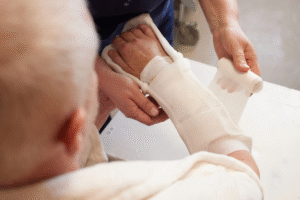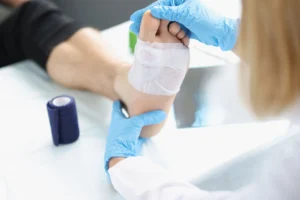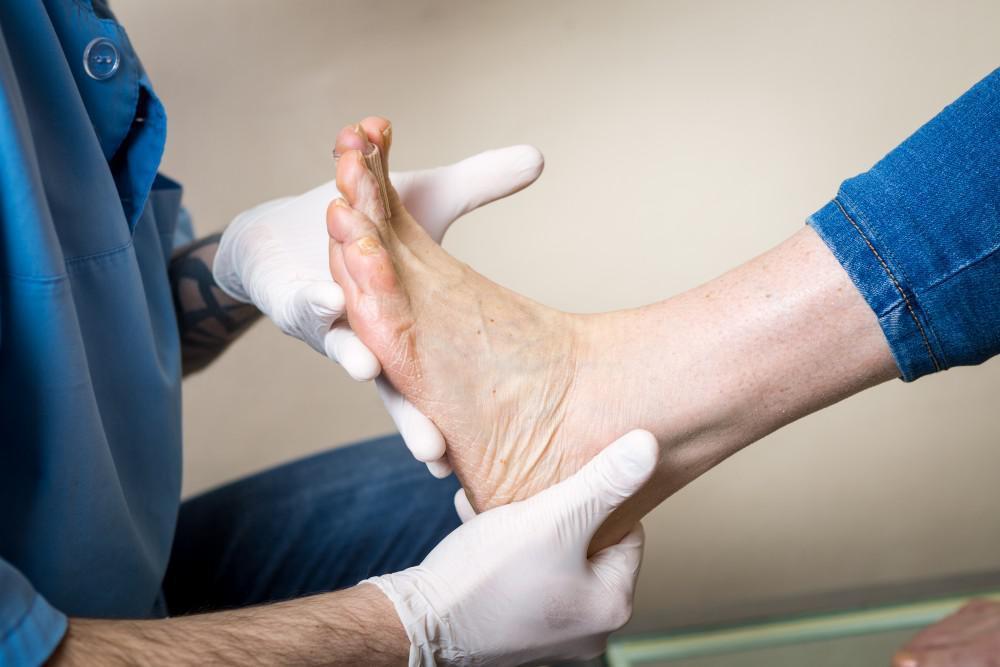Understanding Diabetic Foot Disease
Diabetic foot disease is one of the most serious complications faced by people living with diabetes. The condition arises when high blood sugar levels begin to damage nerves and restrict blood circulation, leading to reduced sensation and slower healing in the feet. Over time, this makes individuals more prone to injuries, ulcers, infections, and bone problems that can worsen without proper care. Many patients may not even notice a cut, blister, or sore due to neuropathy, which is the loss of feeling in the feet. Once left untreated, these small issues can escalate into severe medical problems. Orthopedic specialists play a vital role in addressing these conditions because they focus on bone health, structural alignment, and mobility. Understanding the underlying mechanisms of diabetic foot disease is the first step toward effective treatment and long-term protection.
The Role of Orthopedics in Managing Diabetic Foot Conditions
Orthopedic care is essential for managing diabetic foot problems because the bones and joints are often directly affected by the disease. Orthopedic doctors help evaluate changes in foot structure, detect deformities, and recommend treatments that prevent further complications. Unlike general care that only addresses surface wounds, orthopedic treatment goes deeper by focusing on bone stability and alignment. When bones weaken or shift, the entire structure of the foot becomes unstable, leading to higher risks of ulcers and infections. Orthopedic specialists also work closely with endocrinologists, podiatrists, and wound-care experts to ensure a comprehensive approach. This teamwork is crucial for preventing amputations and maintaining patient mobility. By focusing on structural correction and protection, orthopedic interventions give patients a better chance at preserving independence and quality of life.
Common Orthopedic Complications Linked to Diabetic Foot Disease
Several orthopedic complications are directly associated with diabetic foot disease, and each requires specialized care. Charcot foot is one of the most severe complications, where weakened bones fracture easily and the foot collapses into a deformed shape. This condition makes walking difficult and increases the risk of recurring ulcers. Other deformities, such as hammertoes or bunions, may also develop due to nerve and joint damage, further complicating foot health. Joint instability and fractures occur more often in diabetic patients because the bones become weaker from poor circulation. Osteomyelitis, a dangerous infection of the bone, can also set in when ulcers penetrate deeply, creating life-threatening risks. Each of these conditions highlights why orthopedic treatment for diabetic foot disease is more than just surface-level care. It requires addressing the structural foundation of the foot to reduce pain, prevent infections, and restore function.
Diagnostic Approaches in Orthopedic Care for Diabetic Foot Disease
Early diagnosis is critical for preventing serious outcomes in diabetic foot disease, and orthopedic specialists use several tools to identify issues. Physical examinations help assess range of motion, detect deformities, and check for signs of neuropathy. Gait assessments reveal imbalances in how patients walk, which can indicate early structural changes in the foot. Imaging techniques such as X-rays are often the first step in detecting fractures, while MRI and CT scans provide detailed views of bone and soft tissue damage. Laboratory tests may also be ordered to evaluate infection markers and overall bone health. Combining these diagnostic tools allows doctors to create a tailored treatment plan specific to each patient’s condition. Without thorough evaluation, minor issues can progress into severe complications. This is why routine checkups with orthopedic specialists are highly recommended for people with diabetes.
Non-Surgical Orthopedic Treatments for Diabetic Foot Disease
Not all diabetic foot conditions require surgery; many can be managed through non-invasive orthopedic treatments. Customized footwear and orthotic devices play a critical role in reducing pressure on sensitive areas and preventing ulcers. Orthopedic braces and supports help stabilize weakened joints and allow patients to walk more safely. Casting and immobilization are often recommended for conditions like Charcot foot, giving bones time to heal and preventing further collapse. Offloading devices, such as specialized boots or walkers, shift weight away from problem areas to allow wounds and fractures to recover. Physical therapy is another key component, strengthening muscles and improving mobility to reduce future risks. These treatments not only alleviate pain but also delay or prevent the need for surgery. By prioritizing non-surgical interventions early, patients can protect their feet while maintaining a better quality of life.
Surgical Orthopedic Interventions for Severe Cases
In more advanced cases, surgical procedures may be required to correct deformities and restore function. Orthopedic surgeons can perform corrective surgeries that realign bones and joints, helping patients regain stability in their feet. For those with severe fractures or Charcot foot, bone and joint stabilization procedures may be necessary to prevent further collapse. When infections penetrate the bone, surgical removal of infected tissue, sometimes paired with bone grafting, becomes vital to save the limb. While amputation is considered a last-resort option, it may be the only solution in cases of uncontrollable infection or gangrene. Post-surgical rehabilitation, including physical therapy and custom orthotic support, plays an essential role in recovery. Patients undergoing surgery often experience both physical and emotional challenges, which makes continuous support from orthopedic teams crucial. These surgical approaches highlight the importance of timely intervention to prevent conditions from reaching irreversible stages.
Preventive Orthopedic Strategies to Protect Foot Health
Preventive measures are the strongest defense against diabetic foot complications, and orthopedic specialists emphasize daily routines that protect bone and joint health. Patients are encouraged to inspect their feet daily for blisters, cuts, or swelling, as catching issues early reduces the risk of infection. Choosing well-fitted footwear with adequate cushioning and arch support prevents unnecessary pressure and friction. Orthotic insoles designed by orthopedic professionals provide additional support to reduce strain on weakened areas. Weight management and blood sugar control are also essential, as they directly affect circulation and bone health. Regular orthopedic checkups allow specialists to monitor for subtle changes before they become major problems. Patients who follow these preventive strategies significantly lower their chances of developing severe orthopedic complications. Proactive care is the foundation for long-term mobility and independence in diabetic patients.
Advancements in Orthopedic Treatment for Diabetic Foot Disease
Recent advancements in orthopedic treatment are offering new hope for patients with diabetic foot disease. Innovative surgical techniques now focus on preserving mobility rather than limiting it, with procedures designed to restore natural alignment. Regenerative medicine, including stem cell therapy and growth factor injections, is being explored for its potential to accelerate bone healing and tissue repair. Smart orthopedic devices, such as pressure-sensing footwear, are emerging to help patients monitor their foot health in real time. 3D printing technology is also making strides in producing customized orthotic supports and surgical implants tailored to individual needs. These advancements reflect a shift toward patient-centered care, where the goal is not only healing but also maintaining quality of life. With research and technology evolving, the future of orthopedic treatment for diabetic foot disease looks increasingly promising. Patients can expect more effective, less invasive, and highly personalized options in the coming years.
Lifestyle Adjustments That Support Orthopedic Treatment
Lifestyle changes play an important role in supporting orthopedic treatments and preventing future complications. Exercise routines tailored for diabetic patients, such as low-impact walking or swimming, improve circulation and strengthen muscles without putting excess strain on the feet. Proper nutrition also contributes to bone and nerve health by providing essential vitamins and minerals. Patients are advised to follow a balanced diet rich in calcium, vitamin D, and protein to maintain strong bones. Stress management techniques such as meditation and relaxation exercises further improve overall wellness and aid recovery. Quitting smoking is another critical step since tobacco use restricts blood flow, which delays healing. By combining orthopedic care with these healthy lifestyle adjustments, patients gain better control over their condition and improve their long-term outcomes. This holistic approach ensures that medical treatments are supported by everyday choices that enhance recovery.
Frequently Asked Questions (FAQ)
What is the most common orthopedic treatment for diabetic foot disease?
The most common treatments include specialized footwear, orthotic supports, and braces that relieve pressure and stabilize the foot.
Can diabetic foot deformities be corrected without surgery?
Yes, in many cases deformities can be managed with braces, custom footwear, and offloading devices, especially when detected early.
How can orthopedic specialists prevent amputation?
By providing timely treatment for bone infections, correcting deformities, and using offloading devices, specialists can reduce risks of severe complications.
What type of shoes should people with diabetic foot disease wear?
Patients should wear shoes that are wide, cushioned, and supportive, ideally custom-made or recommended by an orthopedic doctor.
How often should diabetic patients visit an orthopedic doctor?
It is recommended that patients with diabetes schedule at least one orthopedic evaluation per year, or more frequently if symptoms appear.











